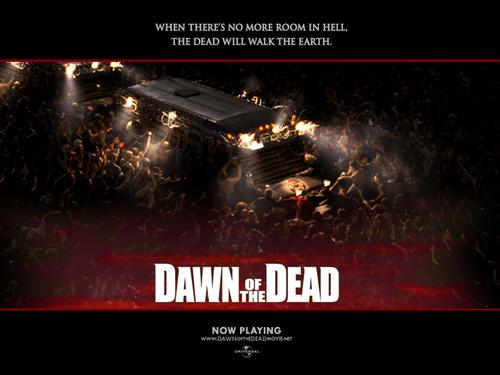August 17, 2005
zombie politics
An uncanny and disturbing convergence last night when, after watching the (surprisingly effective) non-Romero Dawn of the Dead remake, I caught up with the ITV news revelations on the de Menezes shooting, as detailed with typical thoroughness on Lenin's Tomb here and here.
Watching Dawn of the Dead, which keeps faith with zombie movie lore that a zombie nust be shot in the head, one could hardly fail to be reminded of Sir John Stevens' now notorious statement that 'there is only one sure way to stop a suicide bomber determined to fulfill his mission: destroy his brain instantly, utterly.'
In their 'Alien-Nation: Zombies, Immigrants and Millennial Capitalism', ethnographers Jean and John Comoroff describe the way in which the zombie has re-emerged in the vernacular political unconscious of global capitalism. They show that the figure of the zombie and the zombie-maker plug the gaps in narrative produced by newly precarious global conditions. The 'preternatural production of wealth, ... its fitful flow and occult accumulation' and 'the destruction of the labour market by technicians of the arcane' call for a narrative of witchy manipulation, annulment of automony and redemption. (The Comoroffs' 'millenial capitalism' promises damnation and salvation in equal parts.) The zombie becomes associated in particular with that figure steeped in suspicion and exotic dread, the immigrant.
Which return us to de Menezes. One of the most disturbing aspects of the affair is the (apparently) spontaneously-occurring popular fictionalization of the events. De Menezes wore a bulky coat --- he vaulted the barriers ---- he ran away when chalenged by the police ---- The degree to which the authorities were responsible for propagating this wholly untrue account remains unclear (if they are primarily responsible for it, one can only wish that their intelligence before the event were even a fraction as effective as their capacity to cover up after the event.) In any case, it seems that an account was allowed to emerge (with the collusion of the Home Office and the police) which was less a straightforward conspiracy than a managed confabulation. Confabulation is defined as '[t]he unconscious filling of gaps in one's memory by fabrications that one accepts as facts'. Many cases of confabulation are prompted by trauma, by the sudden, violent puncturing of our sense-making capacity by events that exceed our attempts to narrativize them. But this breach of narrative sense is radically intolerable, and, forced to choose between senseless facts and a story that accords with our previous picture of the world, the nervous system will select for the familiar but false.
Two posts on Posthegemonic Musings track this process in relation to the recent Terror attacks in Britain. First, there is the shock itself, the suspension of narrative and of sense; then there is a post-hoc rationalization, in which facts are sacrificed for the sake of narrative coherence and psychological well-being. 'The original accounts, then, are symptomatic of a social fantasy secured by the state. They are elaborated from the original acquiesence that assumes that "por algo será," "there must be a reason," and proceeds to conjure one (or here, several) out of the confusing series of sensations produced in the event itself.' Through such 'percepticide', that 'police and public alike are subject to the state's capacity to organize our perceptions, to secure our complicity with its violence at some level far beneath consciousness.'
Since de Menezes was treated as a subhuman monstrosity, there must have a reason for such treatment. The post-hoc confabulations - de Menezes' wearing of a bulky coat, vaulting of the barrier and running when challenged - fill the gap where no actual reasons exist. The monstering of de Menezes was reinforced by the Home Office's leaking of dubious 'information', significantly, of course, concerning his immigration status. (All of which produced the grotesquely humorous spectacle of people happily accepting the thinnest of pretexts for the shooting: 'well, what did he expect, wearing a bulky coat in hot weather?' 'Well, he wasn't legal, he shouldn't have been there in the first place'.) The most absurd 'signifier of monstrosity' to yet be offered up is de Menezes' supposedly 'Mongolian eyes'. Witness also the counterfactual strategy rightly derided by Bat: : the 'Constant hysterical invocation of an absurd counterfactual scenario: "What if he actually had been a suicide bomber?"'
The new Dawn of the Dead, like Romero's original, is a powerful parable for times of immigration, transnational capital and massive 'precarity'. The objects of dread here are the displaced masses, those who belong nowhere, who have no place to which they can return, and whose one remaining affect is a voracious hunger, for as Steven Shaviro put in 'Capitalist Monsters' (Historical Materialism vol 10:4), 'in the American films [as opposed to the original South African folklore] the zombies are not workers and producers, but figures of nonproductive expenditure. They squander and destroy wealth, rather than create it.' In both Dawns, the human survivor-survivalists famously hole up in a shopping mall, protecting what is 'rightfully theirs' from the hordes of those who have no 'right' to consume but who threaten to do so without limits.
The most powerful moments in the new film, however, happens when the humans leave the mall and board a specially-reinforced motor vehicle. It echoes a similar image in Spielberg's brilliantly traumatic War of the Worlds, (itself an SF riff on Empire and colonialism), where a car - symbol of a besieged American consumer autonomy - is mobbed by the disenfranchised and the desperate. A definitive image of American dread as the great car economy crawls towards collapse....
Posted by mark at August 17, 2005 10:46 AM | TrackBack